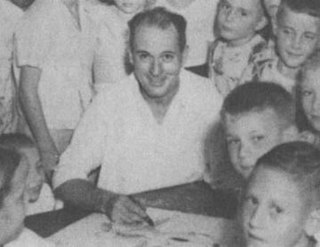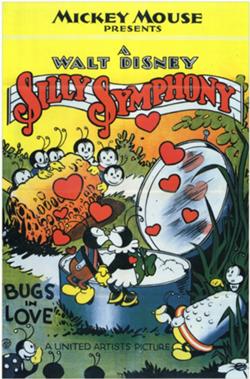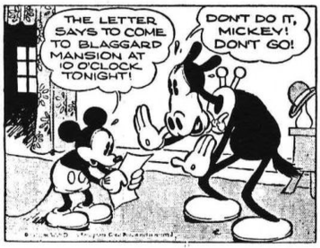
Charles Alfred "Al" Taliaferro, was an American Disney comics artist who produced Disney comic strips for King Features Syndicate. Taliaferro is best known for his work on the Donald Duck comic strip. Many of his strips were written by Bob Karp.

Theodore H. Osborne was an American writer of comics, radio shows and animated films, remembered for his contributions to the creation and refinement, during the 1930s, of Walt Disney cartoon characters.
Silly Symphony is an American animated series of 75 musical short films produced by Walt Disney Productions from 1929 to 1939. As the series name implies, the Silly Symphonies were originally intended as whimsical accompaniments to pieces of music. As such, the films usually did not feature continuing characters, unlike the Mickey Mouse shorts produced by Disney at the same time. The series is notable for its innovation with Technicolor and the multiplane motion picture camera, as well as its introduction of the character Donald Duck, who made his first appearance in the Silly Symphony cartoon The Wise Little Hen in 1934. Seven shorts won the Academy Award for Best Animated Short Film.
Disney comics are comic books and comic strips featuring characters created by the Walt Disney Company, including Mickey Mouse, Donald Duck and Scrooge McDuck.
Bucky Bug is a beetle who appears in Disney comics. He first appeared in the Silly Symphony Sunday comic strip, and later appeared as a regular feature in the comic book Walt Disney's Comics and Stories.
Paul Murry was an American cartoonist and comics artist. He is best known for his Disney comics, which appeared in Dell Comics and Gold Key Comics from 1946 to 1984, particularly the Mickey Mouse and Goofy three-part adventure stories in Walt Disney's Comics and Stories.

Three Little Pigs is a 1933 animated short film released by United Artists, produced by Walt Disney and directed by Burt Gillett. Based on the fable of the same name, the Silly Symphony won the 1934 Academy Award for Best Animated Short Film. The short cost $22,000 and grossed $250,000.
Elmer Elephant is a Silly Symphony cartoon short produced by The Walt Disney Company, directed by Wilfred Jackson and released on March 28, 1936.
Scamp is a canine Disney comics character, the son of Lady and Tramp, all of whom appear in the 1955 animated film Lady and the Tramp. Scamp is featured in comic strips and comic books of his own since the 1950s. In the final scene of the film, the dogs have a litter of puppies, including three girl pups who look like Lady, and a mischievous, restless boy pup who resembles Tramp. The puppies are unnamed in the film and only appear in one scene, but the little boy puppy made an impression, and King Features Syndicate launched a comic strip a few months after the film's release.
Winnie the Pooh is a 1978-1988 daily comic strip based on the Winnie-the-Pooh characters created by A.A. Milne in his 1920s books. The strip ran from June 19, 1978, until April 2, 1988. This is one of many Disney comic strips that have run in newspapers since 1930.
Riley A. Thomson Jr. was an American animator and comics artist who spent most of his career working with Walt Disney films and characters. He directed six Disney short films including The Nifty Nineties and Symphony Hour.

The Bears and the Bees is a Silly Symphonies animated Disney short film. It was released in 1932.

Bugs in Love is a Silly Symphonies animated Disney short film. It was released in 1932, and was the final Symphony to be shot with black-and-white film.

Farmyard Symphony is a 1938 Silly Symphonies animated short film. It can be seen as a precursor to Fantasia due to using various pieces of classical music in one short. The film was directed by Jack Cutting and produced by Walt Disney.

Silly Symphonies: The Complete Disney Classics is a book series which reprints Walt Disney's Silly Symphony Sunday comic strip, drawn by several different Disney artists from 1932 to 1945. The strip was published by King Features Syndicate. The strip often introduced new Disney characters to the public, including its first comic character, Bucky Bug. The series was published by The Library of American Comics from 2016 to 2019.
Donald Duck is an American comic strip by the Walt Disney Company starring Donald Duck, distributed by King Features Syndicate. The first daily Donald Duck strip debuted in American newspapers on February 7, 1938. On December 10, 1939, the strip expanded to a Sunday page as well. Writer Bob Karp and artist Al Taliaferro worked together on the strip for more than 30 years. The strip ended in May 1995.

Mickey Mouse is an American newspaper comic strip by the Walt Disney Company featuring Mickey Mouse and is the first published example of Disney comics. The strip debuted on January 13, 1930, and ran until July 29, 1995. It was syndicated by King Features Syndicate until 1990, when Disney switched to Creators Syndicate, which distributed the strip until 2014.

Mickey Mouse Magazine is an American Disney comics publication that preceded the popular 1940 anthology comic book Walt Disney's Comics and Stories. There were three versions of the title – two promotional giveaway magazines published from 1933 to 1935, and a newsstand magazine published from 1935 to 1940. The publication gradually evolved from a 16-page booklet of illustrated text stories and single-page comic panels into a 64-page comic book featuring reprints of the Mickey Mouse and Donald Duck comic strips.
Silly Symphony is a weekly Disney comic strip that debuted on January 10, 1932, as a topper for the Mickey Mouse strip's Sunday page. The strip featured adaptations of Walt Disney's popular short film series, Silly Symphony, which released 75 cartoons from 1929 to 1939, as well as other cartoons and animated films. The comic strip outlived its parent series by six years, ending on October 7, 1945.
Uncle Remus and His Tales of Br'er Rabbit is an American Disney comic strip that ran on Sundays from October 14, 1945, to December 31, 1972. It first appeared as a topper strip for the Mickey Mouse Sunday page, but after the first few years, almost always appeared on its own. The strip replaced the 1932-1945 Silly Symphony strip, which had spent its final year on gag strips featuring Panchito from The Three Caballeros.









